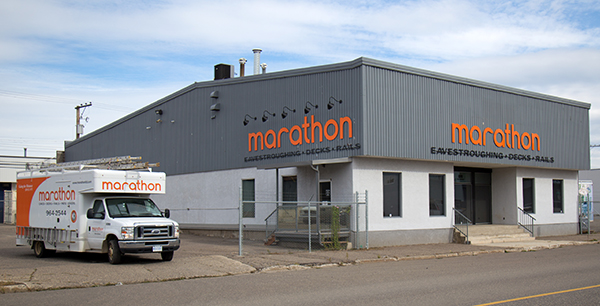Aluminum/steel is more durable, especially up here in the north. It is also continuous so you have no leaks. With vinyl, you will have leaks at every seam. There is also no gap between the aluminum/steel gutter and the facia board, unlike the vinyl gutters.
Ice will form in winter if you have gutters or not. However, ice is usually the result of poor insulation or ventilation (usually both).
Plan to clean your gutters at least once a year, and more often if the roof is directly beneath trees.
If your eavestroughs overflow, it may be because they are clogged and need to be cleaned out (see above). It is also good to check that they are straight and that there is no damage or sags in them.
Only temporarily. Just as they may temporarily stick to the hood of your car, leaves and debris that land on the surface of our leaf guard product dry quickly in the sun. And unlike the hood of your car, the surface beneath the wet leaves on your eavestrough is perforated so they dry faster!
It is a PVC (poly-vinyl chloride) sheet reinforced with a polyester woven backing for strength in all directions, applied as a membrane on deck surfaces to create a 100% waterproof system.
Vinyl decking is designed to be used as a waterproofing product that not only protects but enhances the appearance of the surface to which it is applied. Designed to withstand pedestrian traffic and available in a variety of colours, textures and thickness, it can accommodate almost any application including decks, patios, walkways, stairs, hot tub and pool areas, etc.
Vinyl decking is fully-adhered to most smooth substrates using either a contact or latex adhesive, and is overlapped and heat welded at the seams. The vinyl is then mechanically fastened at all perimeters, ensuring a total waterproofing system is achieved.
As a rule, the lighter the colour you choose, the cooler the surface will stay. Our vinyl decking colours are designed with this aspect in mind.
All vinyl decking has a textured finish in order to provide a non-slip footing, even when wet. However, anything with ice on it is slippery, so please bear this in mind when using your deck in the winter.
No. Vinyl decking is installed by a network of fully trained applicators. They are trained in waterproofing techniques and building codes to ensure you are getting the best quality installation available. For this reason, we are able to offer the industry’s best warranty.
Yes, Rock Salt, Kitty Litter and various other snow-melting chemicals can be used on your vinyl surface. We do caution, however, that you clean the surface thoroughly with soap and water and rinse clear prior to letting the heat of the spring sun "bake" any chemical into the surface.
With proper care and cleaning, your vinyl deck could last for 15-25 years.
The decking is more durable than a kitchen floor.
Vinyl Deck membranes adhere to an acceptable substrate with the use of either a water-based latex or solvent based contact adhesive.
Latex adhesives dry by evaporation. This is a natural process that can take several hours to complete. During this time, the membrane slowly bonds to the substrate. Because this process is susceptible to freezing, most contractors will use solvent-based contact adhesive during the winter season.
Contact adhesives dry by “flashing off”. The installation procedure involves applying a thin coating of adhesive to one surface (i.e. top of plywood deck), letting it dry completely then coating the other surface to be glued (i.e. back of membrane), letting it become tacky and then contacting the two surfaces. The bond strength comes when the molecules of glue physically and chemically mesh together. This is a rapid but not a uniform process. Pockets of still wet solvent adhesive can be trapped under the now partially adhered membrane. These pockets will now take longer to flash off and can cause a “gas bubble” to form.
Many of these gas bubbles will vanish as the adhesive dries. Applying heat to the top of the membrane can temporarily soften Vinyl Deck contact adhesives so the bubble will stick down to the plywood. The solar heat from the sun does this naturally, but this process can take time depending on the season. Other methods are quicker and can often be done by the owner, they include: stepping on the bubble, using a hair dryer set at a medium heat or a clothes iron and damp towel slip sheet, a hot water bottle over the bubbles.
Concentrated or too high of a heat setting could glaze the membrane finish. A plastic spreader can be used to evenly force the membrane down.
Only a qualified installer should apply direct heat using a Hot Air Welding Gun or Directional Forced Air Space Heater.

Phone:
250-964-2544
Toll-Free:
1-800-964-2544
870 3rd Avenue, Prince George, BC
" I had a great experience at MARATHON EAVESTROUGHING LTD. Drew did a great job on the estimate — talked with us about options. The two fellows that did the work were great!! They worked the whole time they were here, did an amazing job, and cleaned up before they left. It only took them a little better that one day!! Another quote I had said that it would take them 4-5 days!!! Much appreciated!! Thank you! "